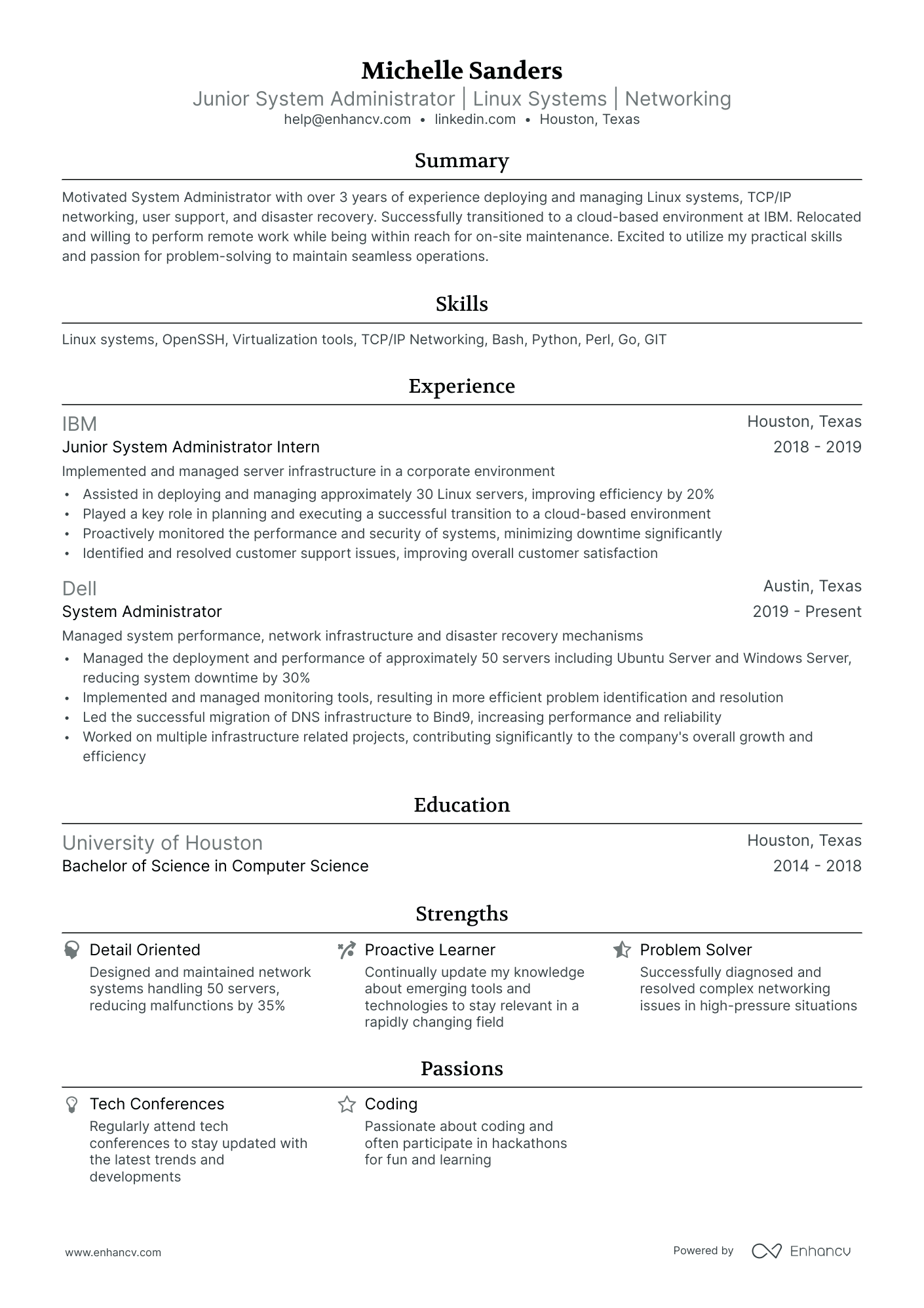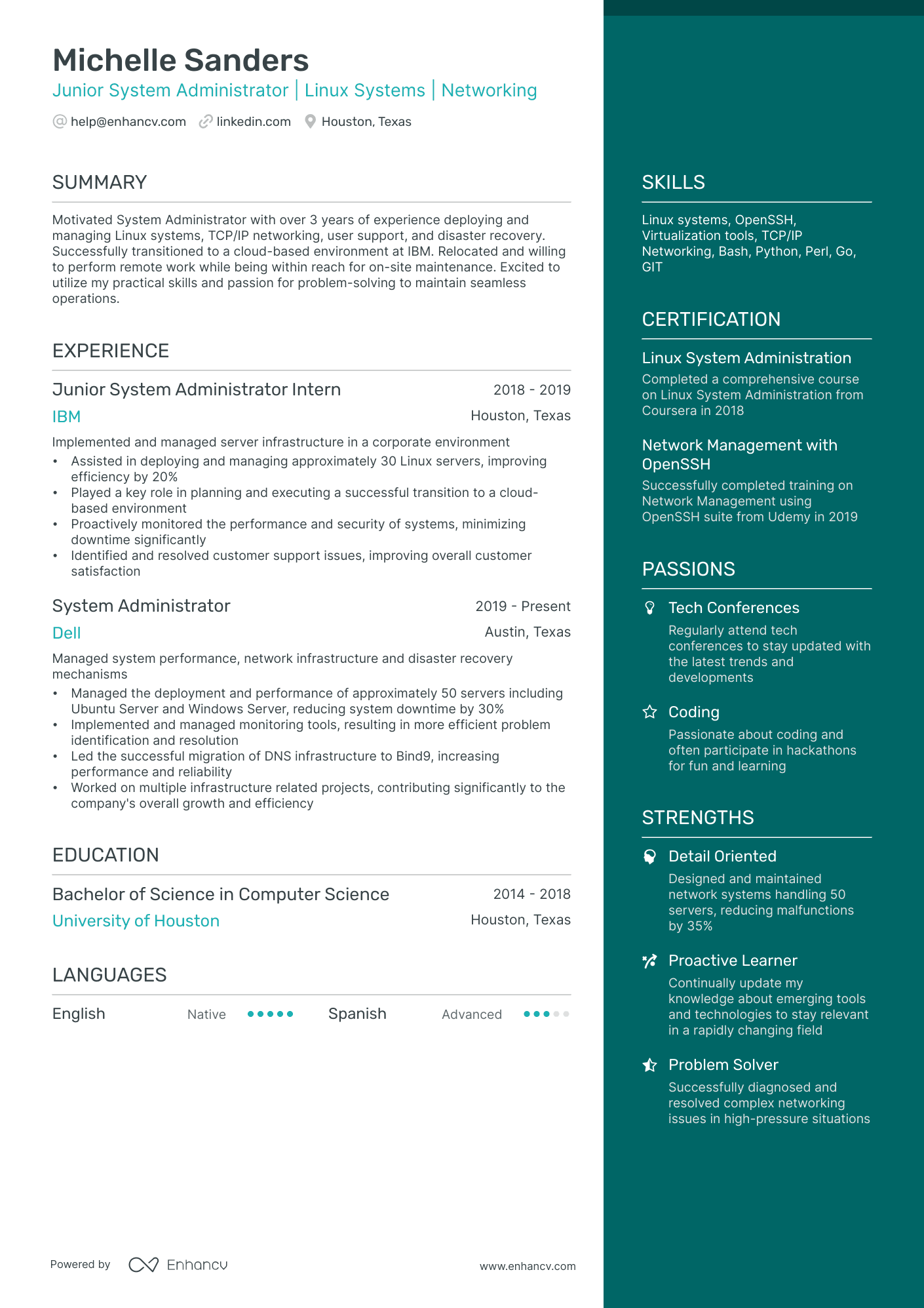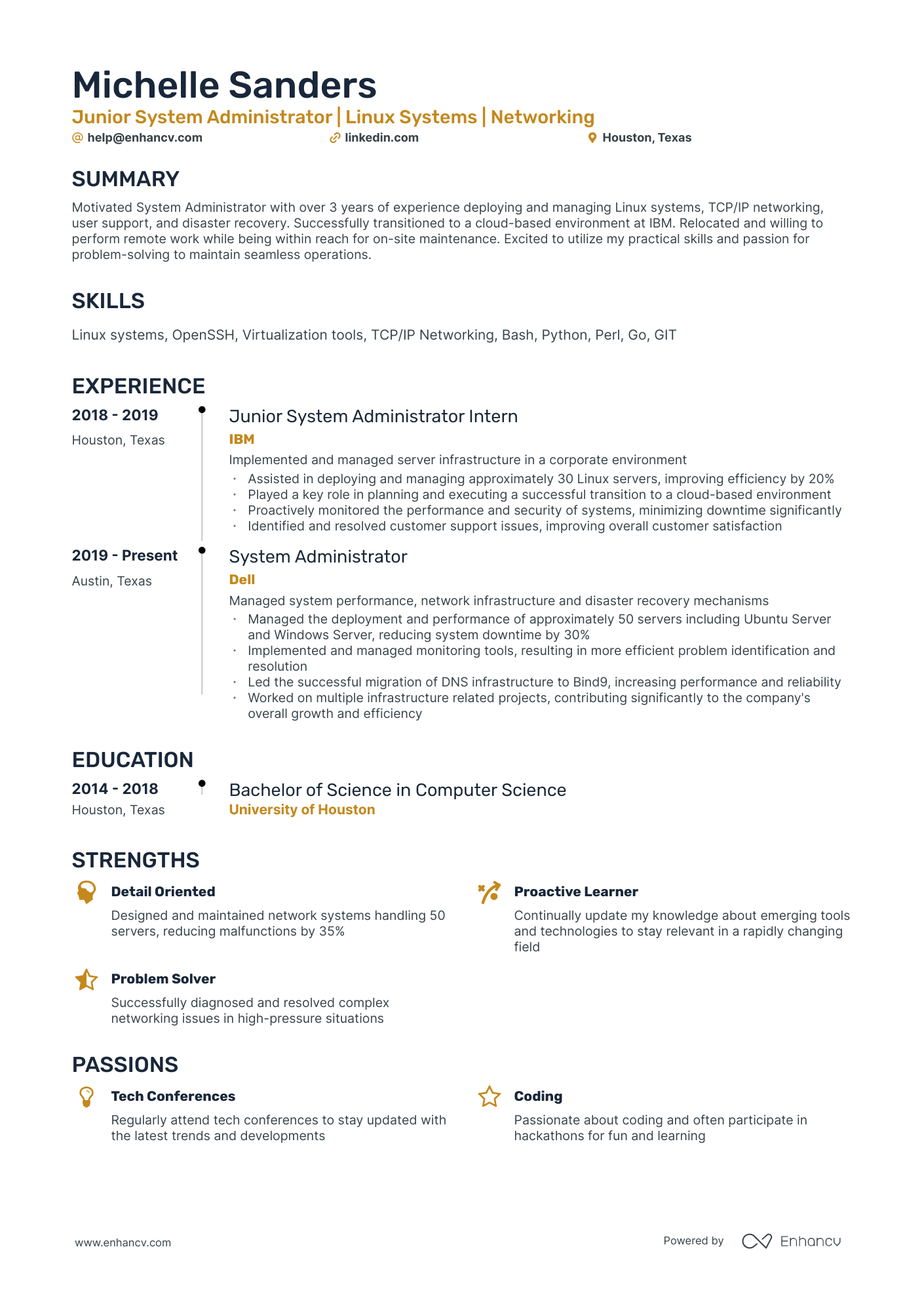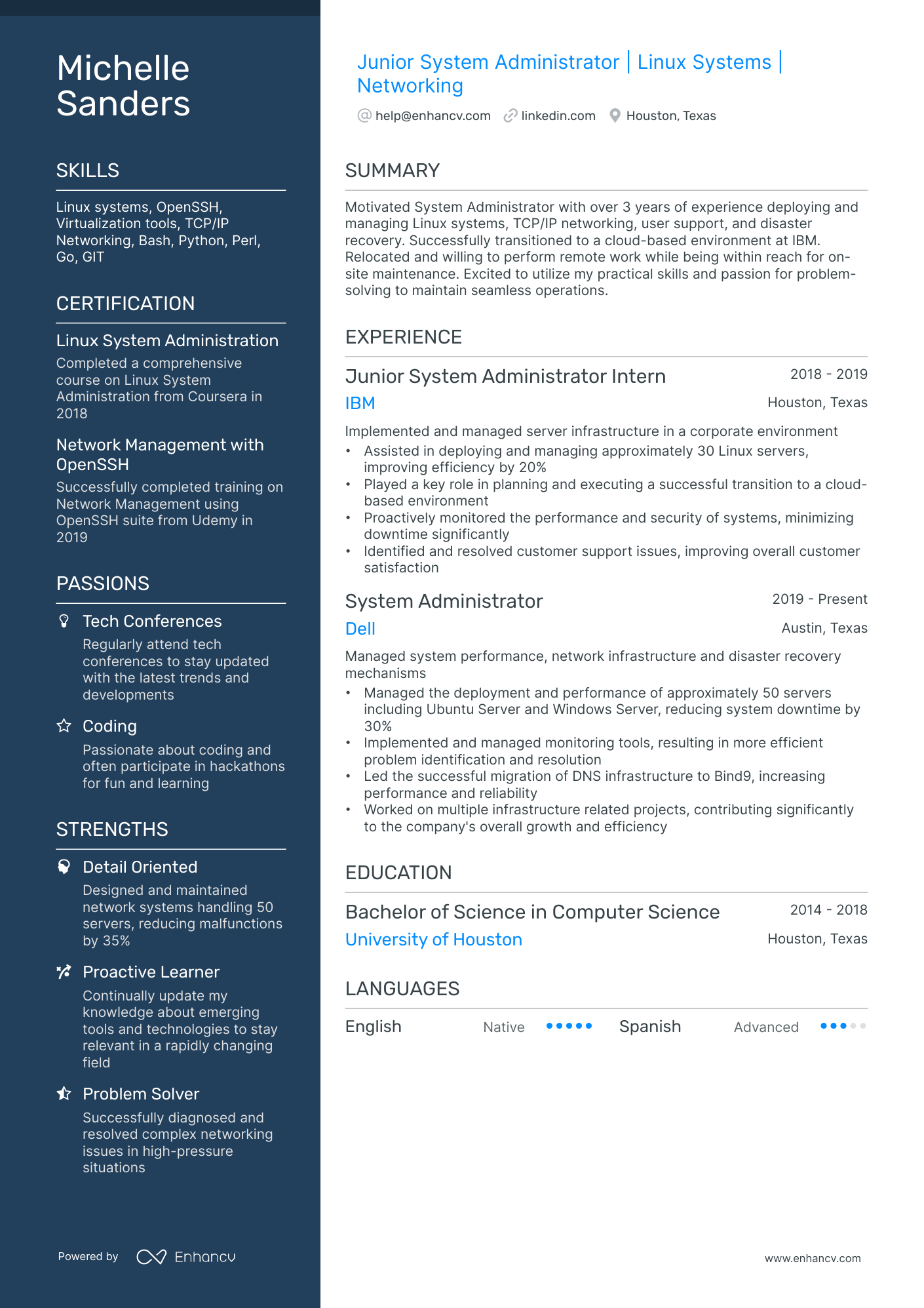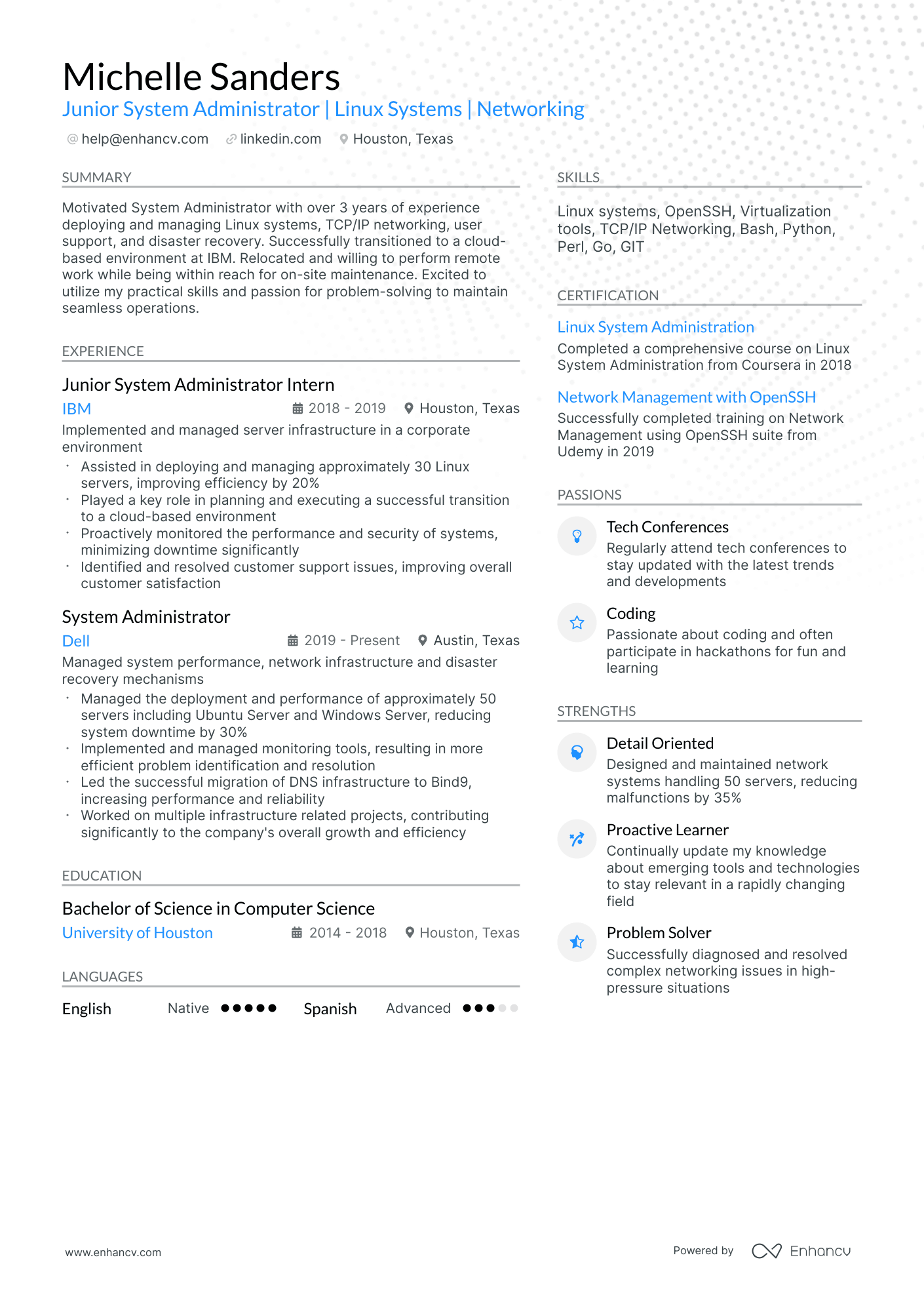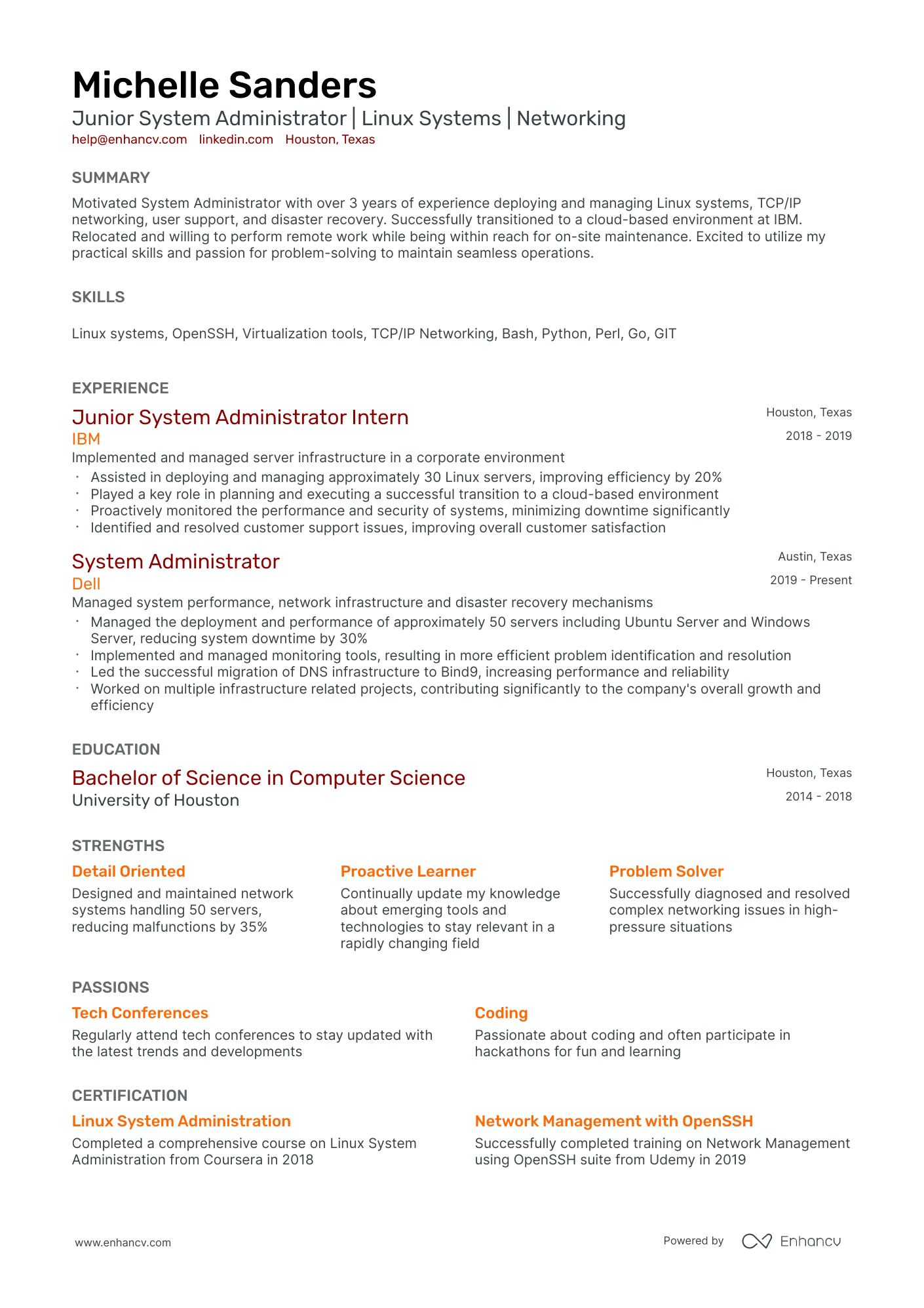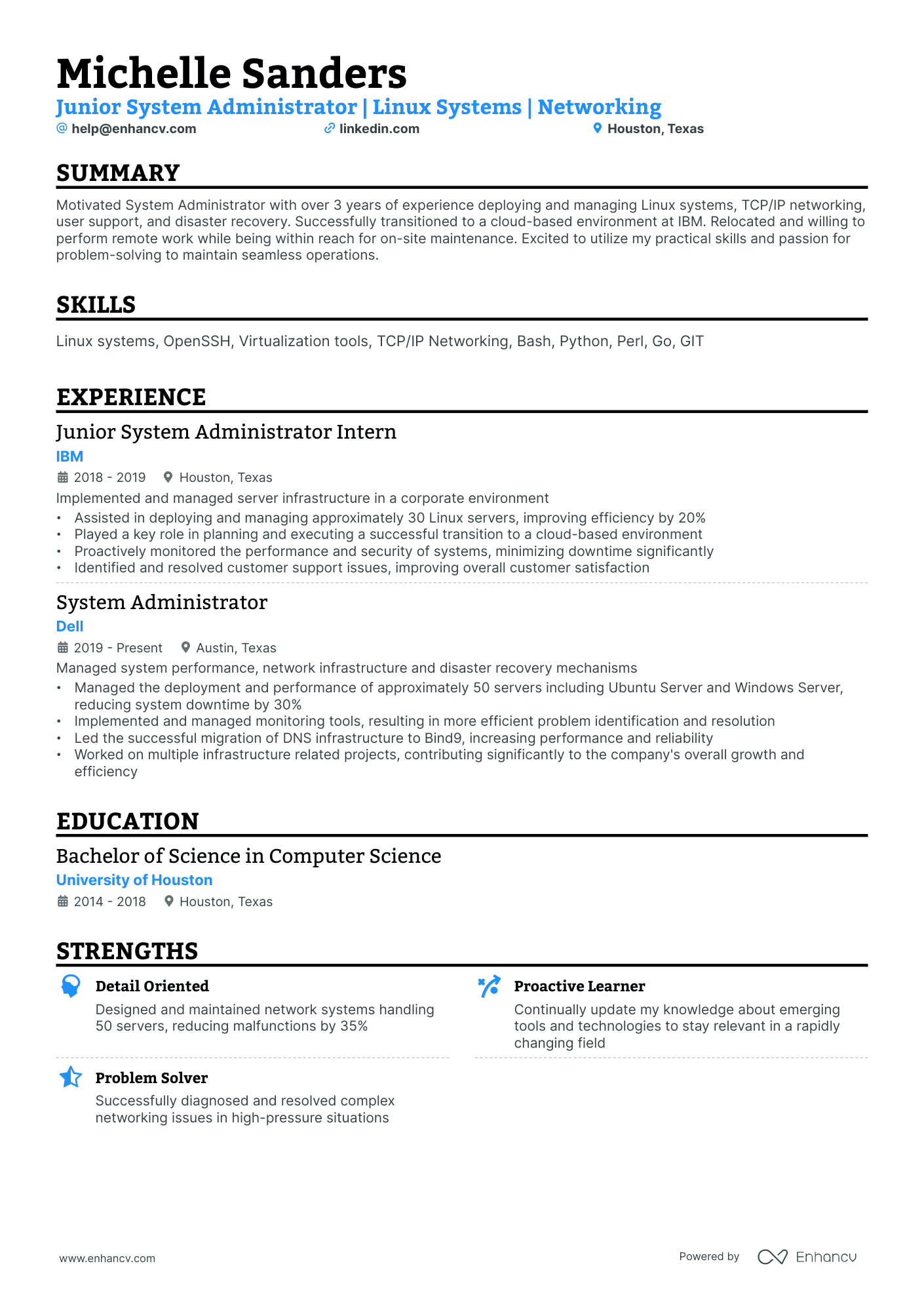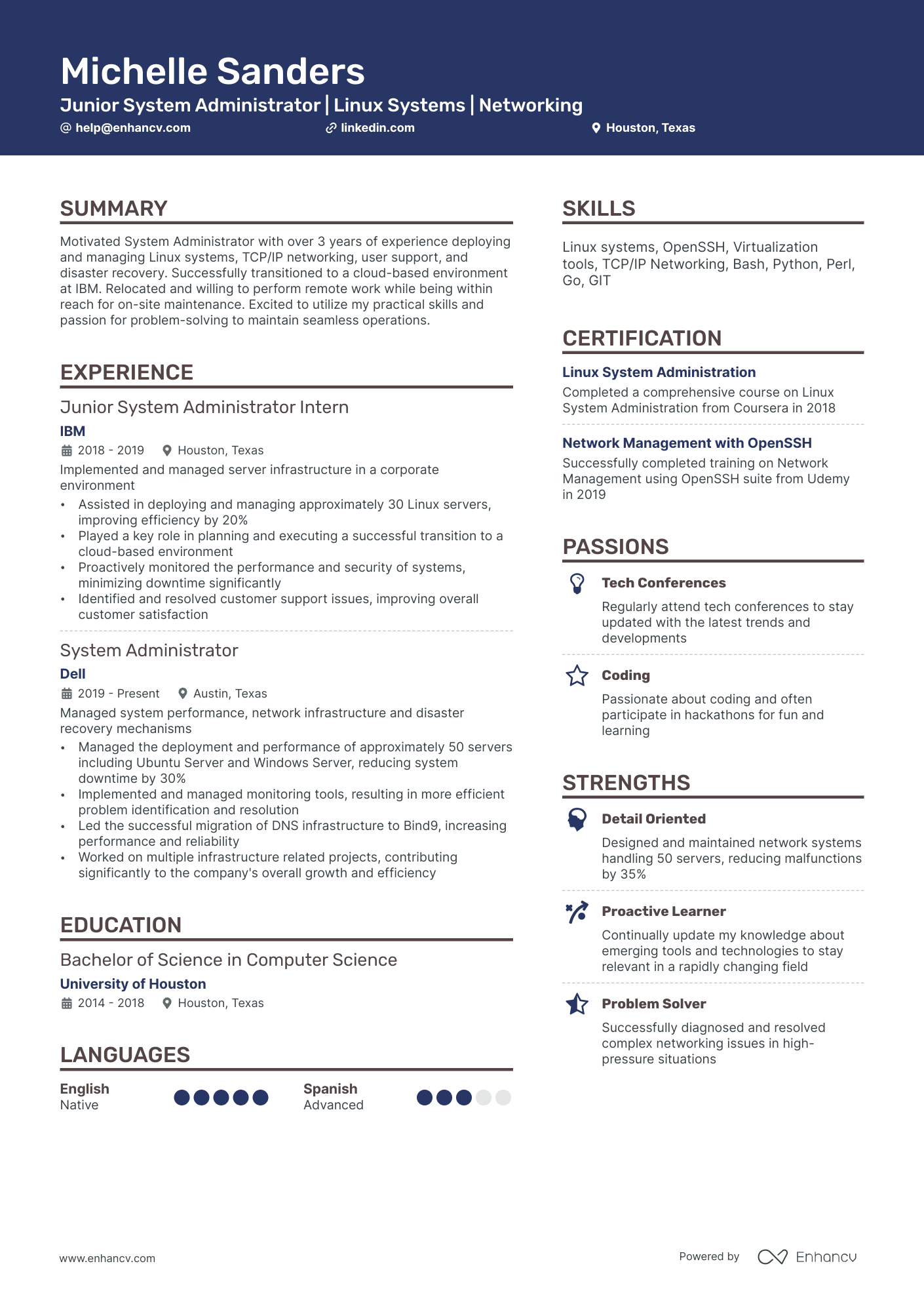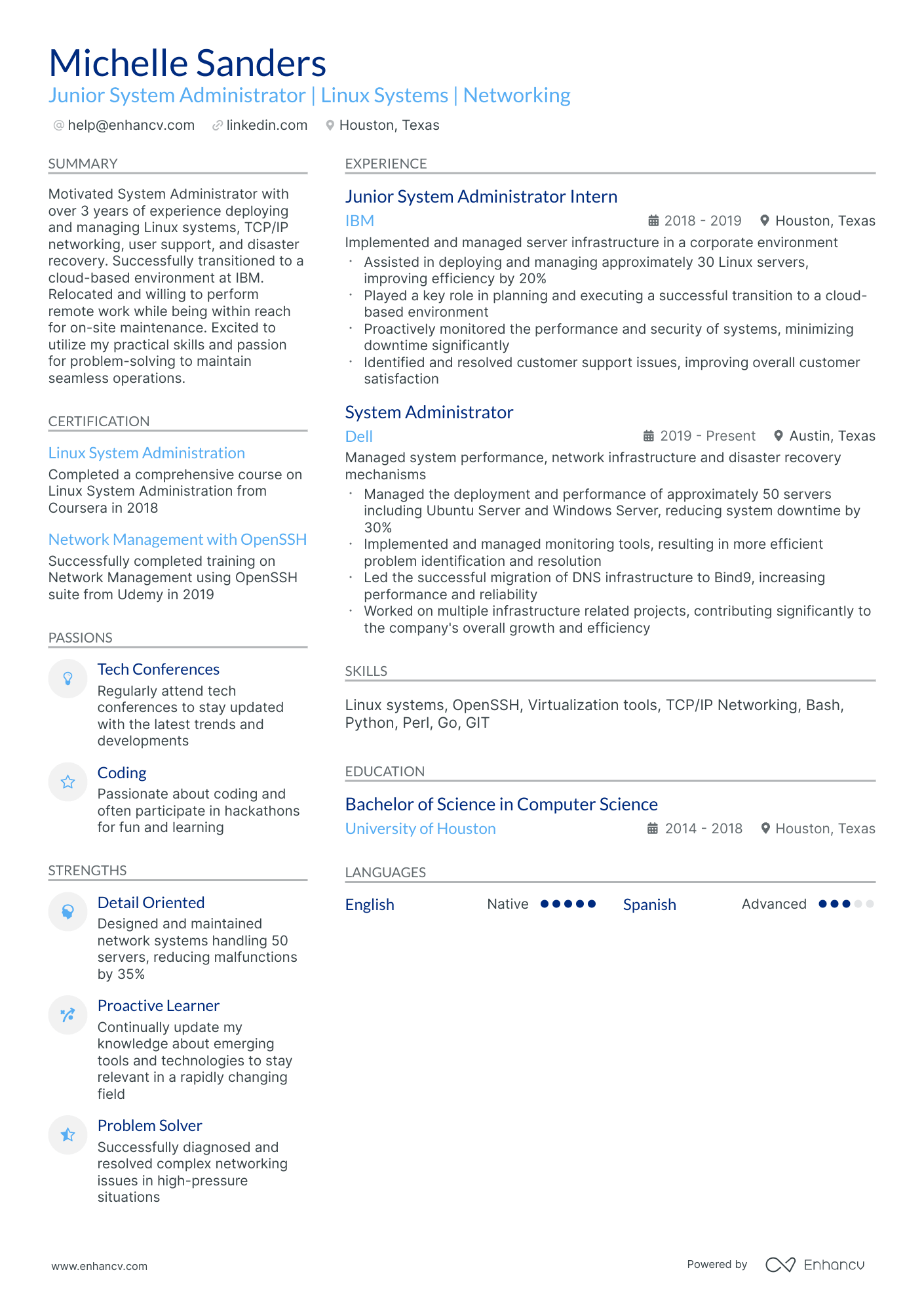A common challenge faced by junior system administrators is articulating their technical skills and experiences in a clear, concise way that appeals to potential employers. Our guide provides tailored advice on how to effectively present these details, with real-life examples and templates that can help shape compelling resume content.
Dive into our concise guide to learn how to:
- Show your junior system administrator career's brightest moments through your resume's summary, objective, and experience sections.
- Explore top-notch junior system administrator resume examples to understand how to distinguish yourself from other candidates.
- Identify the most sought-after junior system administrator skills and certifications in the industry.
- Design a structured yet unique resume layout.
Recommended reads:
Tips for refining your junior system administrator resume format
The resume format sets the stage for your professional narrative. Ensure it:
- Adopts the reverse-chronological format, placing your most recent experiences at the forefront. This format is ideal for those with relevant and up-to-date experience.
- Features a clear headline, making it straightforward for recruiters to access your contact details, portfolio, or current role.
- Stays concise, ideally spanning no more than two pages, focusing on relevant experiences and skills.
- Maintains its layout by being saved as a PDF, ensuring compatibility with Applicant Tracking Systems (ATS).
The layout of a resume can differ by region – Canadian resumes may use a distinct format.
Upload your resume
Drop your resume here or choose a file. PDF & DOCX only. Max 2MB file size.
Pro tip
Prioritize clarity and organization in your junior system administrator resume. Use ample white space, choose readable fonts, and clearly delineate each section.
Don't forget to include these six sections on your junior system administrator resume:
- A header for your contact details and a summary that highlight your alignment with the junior system administrator job you're applying for
- An experience section that explains how you apply your technical and personal skills to deliver successful results
- A skills section that further highlights how your profile matches the job requirements
- An education section that provides your academic background
- An achievements' section that mentions any career highlights that may be impressive, or that you might have missed so far in other resume sections
What recruiters want to see on your resume:
- Practical experience with systems installation, configuration and administration including Windows and Linux OS
- Knowledge of network infrastructure, including routers, switches, firewalls, and the associated network protocols and concepts
- Experience with virtualization technologies, such as VMware, Hyper-V, KVM
- Familiarity with cloud services; AWS, Google Cloud, or Azure
- Strong problem-solving skills and capacity to work well in teams and under pressure
Recommended reads:
Optimizing your junior system administrator resume experience section
Your resume's experience section should resonate with your accomplishments while aligning with the job's demands. Here's how:
- Highlight significant career moments, and back them up with relevant skills.
- Analyze the job description to address both basic and advanced requirements.
- If you have unrelated roles, consider a separate section, but emphasize transferable skills.
- Avoid listing roles from over a decade ago unless they showcase your trajectory, especially for senior roles.
- Illustrate how your contributions enhanced the team or company, linking challenges to solutions.
Review how seasoned junior system administrator professionals have crafted their experience sections, emphasizing their contributions.
- Managed and maintained Windows Server infrastructure, ensuring 99% uptime for critical systems.
- Implemented security measures resulting in a 30% reduction in cybersecurity incidents.
- Assisted in the deployment and configuration of VMware virtualization environment, improving server efficiency by 20%.
- Provided technical support to end-users, resolving 100+ hardware and software issues per month.
- Created and maintained comprehensive documentation for network configurations and troubleshooting procedures.
- Performed system administration tasks for Linux-based servers, optimizing performance and reducing downtime by 25%.
- Collaborated with cross-functional teams to implement backup and disaster recovery solutions, ensuring data integrity and minimizing loss.
- Upgraded network infrastructure, resulting in a 50% increase in network speed and improved overall productivity.
- Assisted in the management of Active Directory, including user account provisioning and group policy administration.
- Participated in the planning and execution of server migration projects, successfully transferring 100+ servers to a new data center.
- Administered and monitored virtualized environments using VMware vSphere, supporting over 200 virtual machines.
- Implemented automated patch management system, reducing patch deployment time by 70%.
- Managed Active Directory, including user provisioning, group policies, and security permissions.
- Collaborated with network engineers to design and implement a scalable and redundant network infrastructure.
- Assisted in the implementation of disaster recovery strategies, resulting in minimal data loss during critical system failures.
- Supported server infrastructure, troubleshooting and resolving hardware and software issues promptly.
- Assisted in the planning and execution of server upgrade projects, ensuring smooth transitions and minimal downtime.
- Managed user accounts and permissions in Active Directory, maintaining accurate records and enforcing security policies.
- Collaborated with the security team to conduct vulnerability assessments and implement necessary remediation measures.
- Participated in disaster recovery drills and documented recovery procedures for critical systems.
- Designing and implementing scalable cloud-based infrastructure using AWS services, optimizing system performance and reducing costs by 25%.
- Managing Kubernetes clusters, automating deployment processes resulting in a 50% reduction in deployment time.
- Implementing and maintaining security controls, ensuring compliance with industry standards and regulations.
- Performing routine system maintenance and monitoring, proactively identifying and resolving potential issues.
- Collaborating with cross-functional teams to develop and execute disaster recovery plans, minimizing downtime in case of system failures.
- Managed and maintained Windows Server infrastructure, ensuring high availability and optimal performance.
- Implemented server virtualization using Hyper-V, resulting in a 30% reduction in hardware costs.
- Developed PowerShell scripts for automating routine administrative tasks, improving efficiency by 40%.
- Collaborated with the networking team to configure and troubleshoot switches, routers, and firewalls.
- Assisted in the planning and execution of server consolidation projects, reducing energy consumption by 20%.
- Administered Linux servers in a high-availability environment, ensuring 99.9% uptime for critical systems.
- Implemented monitoring solutions such as Nagios and Zabbix, reducing response time to system issues by 50%.
- Managed user accounts and access control in LDAP directory service, enforcing security policies and maintaining accurate records.
- Collaborated with software developers to deploy applications in DevOps environment, streamlining the release process.
- Assisted in the design and implementation of disaster recovery strategies, minimizing data loss and downtime.
- Supported Windows-based servers, troubleshooting and resolving technical issues in a timely manner.
- Assisted in server room operations, including rack installation, cable management, and equipment inventory.
- Performed routine backup operations and ensured data integrity and reliability of critical systems.
- Collaborated with the network team to configure and maintain network switches, routers, and firewalls.
- Participated in disaster recovery testing and documented procedures for system restoration.
- Managed and maintained hybrid cloud infrastructure, combining on-premises and Azure resources for optimal performance.
- Implemented automation tools such as Ansible and Terraform, reducing deployment time by 40%.
- Assisted in designing and implementing network architecture, ensuring seamless connectivity among multiple locations.
- Collaborated with cross-functional teams to develop incident response plans and perform root cause analysis.
- Provided end-user support and training, resolving technical issues and improving overall user satisfaction.
- Managed and supported Windows-based server infrastructure, ensuring high availability and data integrity.
- Implemented virtualization technologies (VMware ESXi) and consolidated servers, reducing hardware costs by 30%.
- Administered Microsoft Exchange Server, including mailbox management and email system troubleshooting.
- Collaborated with the security team to conduct vulnerability assessments and implement security best practices.
- Assisted in the planning and execution of system upgrade projects, minimizing potential disruptions to business operations.
Quantifying impact on your resume
<ul>
Strategies for candidates with limited resume experience
Lack of extensive experience doesn't mean you can't make a strong impression. Here's how:
- Thoroughly understand the role's requirements and reflect them in key resume sections.
- Highlight transferable skills and personal attributes that make you a valuable candidate.
- Use the resume objective to articulate your growth vision within the company.
- Emphasize technical alignment through relevant certifications, education, and skills.
Remember, your resume's primary goal is to showcase how you align with the ideal candidate profile. The closer you match the job requirements, the higher your chances of securing an interview.
Recommended reads:
Pro tip
Remember, the experience section isn't just about traditional roles. It's a space to highlight all professional learning, whether from internships, contract roles, research projects, or other relevant experiences. If it's added value to your skill set for the junior system administrator role, it deserves a mention.
Spotlighting your junior system administrator hard and soft skills
Hard skills denote your technological proficiency and expertise in specific tools or software. These skills are often validated through certifications and hands-on experience.
Soft skills, on the other hand, reflect your interpersonal abilities and how you navigate workplace dynamics. These skills are cultivated over a lifetime and can be more nuanced.
Why the emphasis on both? Hard skills demonstrate your technical competence and reduce training needs. Soft skills suggest adaptability and cultural fit.
To optimize your skills section:
- Forego basic skills like "Excel" in favor of more specific proficiencies like "Excel Macros".
- Highlight core values and work ethics as soft skills, indicating what you prioritize in a professional setting.
- If relevant, create a distinct section for language proficiencies.
- Balance hard and soft skills by crafting a strengths or achievements section, illustrating outcomes achieved through both skill sets.
To assist you, we've curated a list of skills highly sought after by recruiters. Ensure you integrate those that resonate with your expertise and the prospective employer's needs:
Top skills for your junior system administrator resume:
Windows Server Administration
Linux Administration
Active Directory Management
Network Configuration
Virtualization Technologies (e.g., VMware, Hyper-V)
Backup and Recovery Solutions
Basic Scripting (e.g., PowerShell, Bash)
Troubleshooting Hardware and Software Issues
Firewall and Security Management
Cloud Services (e.g., AWS, Azure)
Problem-Solving
Communication
Teamwork
Time Management
Adaptability
Attention to Detail
Customer Service Orientation
Critical Thinking
Organizational Skills
Willingness to Learn
Pro tip
When detailing your skills, always back them up with tangible evidence, be it quantifiable results or certifications.
Detailing your education and top junior system administrator certifications on your resume
Your education section can reflect a variety of skills and experiences relevant to the position.
- List post-secondary qualifications, noting the institution and duration.
- If you're currently studying, mention your expected graduation date.
- Exclude qualifications unrelated to the role or industry.
- If relevant, delve into your educational background, especially if it was research-intensive.
Including both relevant education and certifications on your junior system administrator resume can set you apart. It not only showcases your qualifications but also your commitment to the profession.
When listing these on your junior system administrator resume, make sure to:
- Highlight degrees and certificates relevant to the role.
- Mention the awarding institution for credibility.
- Include the start and end dates, or if the education/certification is ongoing.
- If relevant, incorporate a few keywords from the job advert within the description of the certification or degree.
If you have additional certifications not directly related to the role, consider placing them towards the end of your resume. This way, they can be viewed as personal interests rather than core qualifications.
For a quick update, check out our list of popular junior system administrator certifications curated by the Enhancv team.
Best certifications to list on your resume
- CompTIA A+ - CompTIA
- CompTIA Network+ - CompTIA
- CCNA Routing and Switching - Cisco
- RHCSA: Red Hat Certified System Administrator - Red Hat
- CompTIA Security+ - CompTIA
- AWS Certified SysOps Administrator - Amazon Web Services
- VCP-DCV: VMware Certified Professional - Data Center Virtualization - VMware
Pro tip
If you have basic certificates, place them in the skills or experience section. This saves space for high-demand industry certificates.
Recommended reads:
Summary or objective: making your junior system administrator resume shine
Start your resume with a strong summary or objective to grab the recruiter's attention.
- Use a resume objective if you're newer to the field. Share your career dreams and strengths.
- Opt for a resume summary if you have more experience. Highlight up to five of your top achievements.
Tailor your summary or objective for each job. Think about what the recruiter wants to see.
Resume summary and objective examples for a junior system administrator resume
Enhancing your junior system administrator resume with additional sections
Make your junior system administrator resume truly distinctive by adding supplementary sections that showcase:
- Awards that underscore your industry recognition.
- Projects that bolster your application's relevance.
- Hobbies, if they can further your candidacy by revealing facets of your personality.
- Community involvement to highlight causes you champion.
Key takeaways
- The format and layout of your junior system administrator resume should reflect your career experience;
- Use the resume summary and objective to highlight your most prominent accomplishments;
- Always be specific about your experience and consider what value each bullet adds to your junior system administrator application;
- Consider how your academic background and technical capabilities could further showcase your alignment to the role;
- Your soft skills should contribute to your overall junior system administrator profile - aligning your personality with your professional self.
